Three Tips for Comprehensive User Experience Assurance in 5G

In 2019 many CSPs around the world started trials and rollouts of 5G networks. Several countries were busy getting ready for 5G rollouts by spectrum auctions, infrastructure contracts among other readiness initiatives. Last year, in 2020, we did see some impact on both the rollouts as well as on the readiness for 5G. In spite of global lockdowns due to COVID-19, there was near zero impact on CSP revenue during 2020 thanks to a shift from network usage in office premises to personal premises. It’s true that enterprise mobile and fixed services did witness a big decline, while consumer services remained resilient. Additionally, we witnessed a significant increase in internet traffic, movement to cloud, adoption of remote collaboration applications and so on.
However, the isolation induced by efforts to contain COVID-19 has underscored the importance of communication technology in keeping social networks connected and economic systems resilient. The economics behind the value of 5G use cases in a post-pandemic world is one of the reasons why investments in 5G technology did not fall off the cliff during the economic downturn that followed the onset of COVID-19; even as many other investment activities saw sharp declines. In fact, IHS Markit’s forecast showed a 10.8% net increase in global 5G investments and R&D during 2020-35 compared to the 2019 forecast. It is evident that the need for expanded connectivity in the COVID-19 era is invigorating 5G investment growth.
- Especially the following use cases are estimated to have an accelerated demand
- Working From Home (WFH): CSPs had an immediate responsibility of enabling remote working and connectivity for citizens, providing extensions to data consumption packages and facilitating additional quota during the lockdowns globally.
- Distance learning
- Tele-health/medicine
- Online retail and e-Commerce
As we have discussed earlier, 5G has three main application areas and use cases: (a) Enhanced Mobile Broadband (eMBB) (b) massive machine type communication (mMTC) (c) and Ultra-Reliable Low Latency Communication (URLLC) or like many reports – like the one below – talk about Mission Critical Services. In the media, 5G has mainly said to provide higher speeds, especially to consumers. And obviously consumers are interested in higher speeds, however most of the consumers aren’t just willing to pay anything extra when compared to their existing 4G subscriptions. If you look what the operators are doing, it proves that the largest Tier-1 service providers aren’t asking for anything extra for the 5G services from the consumers.
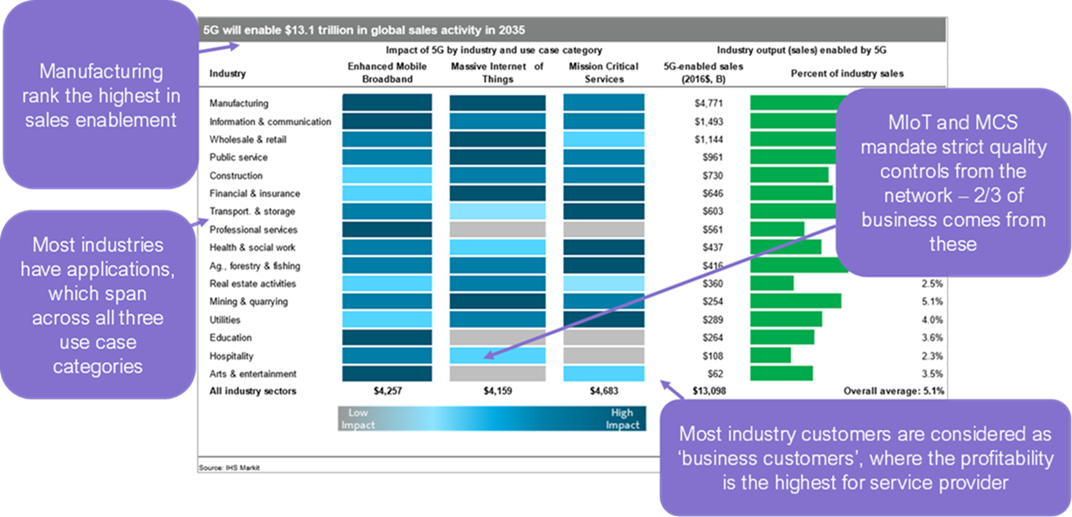
Picture 1. 5G Impact by Industry and Use Case in 2035 (Source HIS Markit).
Industries, such as manufacturing, financial and insurance and public/critical communication services, will span across all three use case categories. Those need high capacities, but at the same time the highest possible quality. Also, if you look more closely at the end customers for mMTC and mission critical services like businesses, mining companies, financial organisations or critical communication providers, the report above shows that 2/3 of the predicted revenues in 2035 will require low latency (even down to 1ms), low packet loss, the best possible network as well as service availability. In certain use cases even 99.9999% network availability will be a hard requirement.
Thus, businesses will be driving the revenues and profits for 5G. At the same time, these kinds of organisations are also used to require the best quality and Service Level Agreements (SLA). According to several sources more than 80% of the service providers say that the SLAs are required to sell 5G, and end customers will require live service and network availability reporting, too.
Additionally, the SLAs will change. In the 4G networks the network measurements were network centric, the focus was only on the network level Key Performance Indicators (KPI). However, IoT, Cloud, Edge Computing and so on are increasing requirements to measure the Quality of Experience (QOE), too. Meaning that both the SLAs and the scope in measurement are changing from network centric measurements to service centric measurements. Here’s an example; if in 4G networks service providers predominantly monitored the quality from the EPC to a base station, in the new 5G use cases the monitoring will be done from the cloud to the end user/ end user terminal. That is a significant change and therefore the end-user experience is critical.
Again, if you think of an enterprise service, what could go wrong as the connection is from the enterprise location over 5G networks to the cloud? At the enterprise location one of the most typical issues is a bad WIFi, bad signal quality, the authentication doesn’t work or DL/UL capacity is really bad. Also, the connectivity to certain business critical web services – which are typically located in the cloud – may be poor. And last but not the least, also 5G radio performance, poor S/N ratio or poor signal quality overall can have a significant impact on how users perceive the 5G service. Thus, in addition to the normal KPIs such as latency, packet loss, jitter and bandwidth, there are new KPIs that also need to be measured.
Below we have listed three tips for establishing a holistic solution for User Experience Measurement:
1. Extending the Measurement Reach
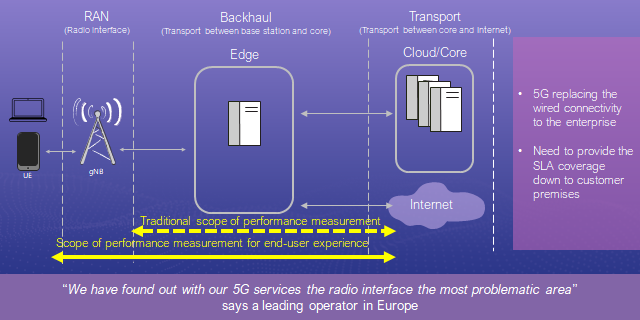
As explained above, the SLAs and the scope in measurement are changing from network centric measurements to service centric measurements. 5G is replacing the wired connectivity for the enterprises, additional use cases such as autonomous vehicles, automation, robotics and so on will require that the measurement reach is extended all the way to the end device. In many deployments the radio interface is actually generating most of the delay and quality issues, thus it needs to be also included to the measurements and be part of the SLAs.
2. Dividing the Connection into Segments
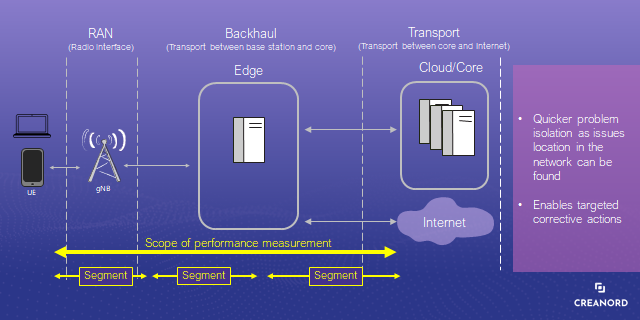
Second tip is to divide the end-to-end connection into segments. According to Heavy Reading 98% of the quality issues that end-customers are experiencing are actually invisible, those are just short 10–20-minute performance degradations and service providers today don’t have the visibility and tools to resolve those. Obviously, it is a good start to monitor the end-to-end connection, but in case there are any issues, it is critical to reduce the problem isolation time. Where the problems actually happen. This problem isolation time can be reduced by dividing the end-to-end connection into segments. Network segmentation support will automatically show whether the issues are taking place in the radio interface, or in the front/mid/backhaul part of the network. Actually, active testing can be performed between any two sites along the same end-to-end service path; thus, it will be possible to calculate the quality of the individual network segments which will provide real-time visibility to where the potential issues are actually located.
3. Covering the Necessary Set of Test Types
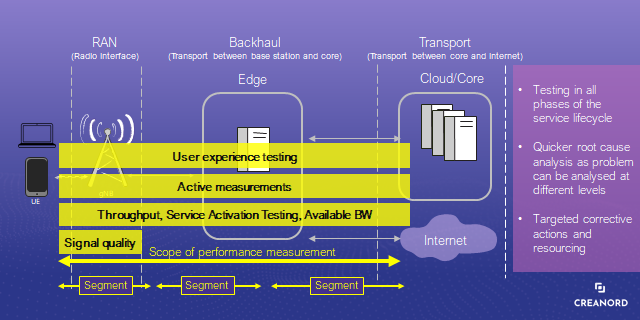
Performance and quality monitoring at the network level, which is the layer common for all services, is the most fundamental for service providers. The key metrics to be measured and monitored are latency, jitter, packet loss and throughput. Additionally, the signal quality can have a significant impact on the customer experience.
While these Key Performance Indicators (KPI) provide good insights on the network quality, there are still possible problems related to infrastructure and application performance that it cannot discover, which are still visible for the end-users.
Therefore, it is crucial to extend the continuous measurements from network level to infrastructure and user experience monitoring as well. These measurements provide information to service providers on how usable the services are for the end-users and whether service and application infrastructure is working with adequate response times. The web application UX testing measures, for instance, how quickly the domain name system lookup works. Every time you browse to a new URL, you will need to resolve the web server name to a particular IP address. If your lookups take a long time, it directly impacts your user experience. Also, if the server you communicate with is overloaded, it will take a long time for it to respond to you, again impacting the user experience. It is worth noting that these types of issues can be perceived by the user as the network performing bad, but active network monitoring would not show any issues with the network when the actual issues are with the compute or infrastructure functions.
To conclude, it is important that you measure the performance from many different aspects with the right combination of measurement types. In the table below, we summarize the recommended measurement types and networking layers along with the motivation for each measurement type:
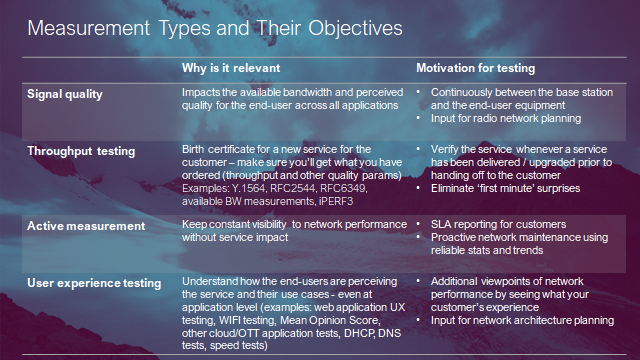
Picture 2. The recommended measurement types and networking layers.
With the PULSure solution, Creanord brings you a full suite of tools for monitoring all aspects of User Experience in 5G, cloud communication, critical communications, enterprise, and wholesale carrier networks as described above. With physical and virtual probes as well as an AI/ML powered analytics engine, PULSure will refine millions of raw data points into insights and actions to make your network run at optimal levels and maximize the user experience. Please checkout our website, webinars and fantastic features videos and schedule a demo with us to learn more on what PULSure can do to put you in control of your network.